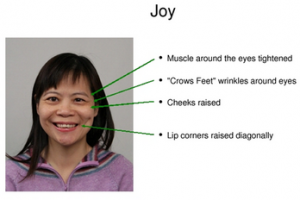Reading Faces to Decode Emotional States
Emotions play a huge role in how our minds work. They shape and sometimes determine how we learn, make decisions, solve problems, change behavior and interact with others. Decoding emotions is critical step in cognitive design no matter what application you are working on.
 Emotions are visible through actions, body-language (especially facial expressions) and words. Learning to read emotions in people and animals is not only good cognitive design, it builds emotional intelligence. A well-known observational technique plays off the assumption that our biology determines how our facial muscles react when we experience a basic emotion such as surprise, fear, joy, disgust, anger, contempt and sadness. I frown when sad, my eyes widened when surprised and so on.
Emotions are visible through actions, body-language (especially facial expressions) and words. Learning to read emotions in people and animals is not only good cognitive design, it builds emotional intelligence. A well-known observational technique plays off the assumption that our biology determines how our facial muscles react when we experience a basic emotion such as surprise, fear, joy, disgust, anger, contempt and sadness. I frown when sad, my eyes widened when surprised and so on.
Of course it is more complex than that. For a deeper dive, check out Humintell’s microexpression recognition training, especially the tab on The Science.
Over the years of use I have noticed individual differences in how emotions play out on faces, perhaps due to context or something more fundamental. For instance, some people narrow their eyes when surprised or smile when angry. While I could never prove they were in a base emotional state and exhibited a facial expressions that conflicts with the standard view, my experience supported it. And the closer I looked the more variation I found.
Now there is a small but growing body of scientific work that is focused on the variations in the facial expression of emotions. A recent press release by the Association for Psychological Science highlights some of the work:
“Contrary to what many psychological scientists think, people do not all have the same set of biologically “basic” emotions, and those emotions are not automatically expressed on the faces of those around us, according to the author of a new article published in …”
The note goes on to claim:
“Some scientists have proposed that emotions regulate your physical response to a situation, but there’s no evidence, for example, that a certain emotion usually produces the same physical changes each time it is experienced, Barrett says. “There’s tremendous variety in what people do and what their bodies and faces do in anger or sadness or in fear,” she says. People do a lot of things when they’re angry. Sometimes they yell; sometimes they smile.”
The implications for cognitive design are clear. General rules for decoding emotions from facial expressions are fine but they only go so far. In complex or high-risk situations the real value might be in the variations from those rules.
Source of Image: Seven Basic Emotions
February 23rd, 2014 at 4:18 pm
http://traveler.co-blog.jp/dressesauing/…
Cognitive Design » Blog Archive » Reading Faces to Decode Emotional States…
July 5th, 2014 at 6:36 am
cappuccino…
Cognitive Design » Blog Archive » Reading Faces to Decode Emotional States…
November 28th, 2014 at 2:01 pm
canada goose coat…
magasin hollister abercrombie france canada goose femme abercrombie et fitch hollister doudoune moncler botte ugg doudoune canada goose pas cher ugg pas cher moncler outlet uk canada goose coat ugg uk moncler outlet abercrombie italia moncler piumini u…
December 27th, 2014 at 8:03 pm
Kid’s Goose Expedition Parka…
abercrombie canada goose pas cher moncler uk canada goose coat mens moncler jackets uggs sale cheap ugg boots uk bottes ugg doudoune canada goose femme Moncler Vests Men Abercrombie Short Canada Goose Enfant UGG Classic Argyle Knit 5879 Canada Goose Pb…